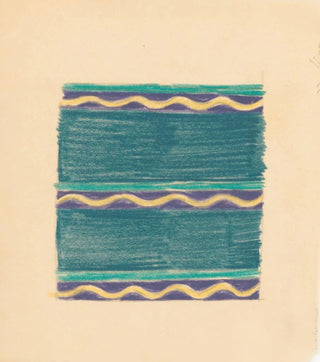Art print | Various small sketches for inlaid table tops Pattern with green lines and a yellow wave motif - Winold Reiss


View from behind

Frame (optional)
In the rich and diverse universe of decorative art, the work of Winold Reiss stands out for its delicacy and originality that inspire admiration. The art print of his "Divers petits croquis pour plateaux de table incrustés Motif avec des lignes vertes et un motif de vagues jaunes" immerses us in a world where color and shapes intertwine harmoniously. These sketches, imbued with movement and fluidity, evoke not only nature but also an artistic sensitivity that transcends eras. Through these works, Reiss invites us to explore the subtleties of decorative design while celebrating the beauty of motifs that adorn our daily lives.
Style and uniqueness of the work
Winold Reiss's style is characterized by a bold blend of influences, where modernism and artisanal traditions intertwine. In these sketches, the green lines evoke lush vegetation, while the yellow waves bring a dynamic sense reminiscent of water's movement. Each element is carefully thought out, creating an interaction between colors and shapes that captivates the eye. The lightness of the motifs seems to dance across the surface, offering a visual experience that goes beyond mere decoration. Reiss, a true master of decorative art, manages to transform everyday elements into genuine works of art, thus adding a poetic dimension to utilitarian objects. His innovative approach demonstrates a rare sensitivity, where each art print becomes a dialogue between art and functionality.
The artist and his influence
Winold Reiss, a German-born artist, made a significant impact on the American art scene in the early 20th century. His journey is marked by an relentless quest for authenticity and innovation. Influenced by the Arts and Crafts movement and modernism, he always sought to incorporate beauty into daily life. His ability to fuse traditional elements with contemporary ideas paved the way for new forms of artistic expression. Reiss was also a pioneer in the use of decorative motifs, inspiring many artists and

Matte finish

View from behind

Frame (optional)
In the rich and diverse universe of decorative art, the work of Winold Reiss stands out for its delicacy and originality that inspire admiration. The art print of his "Divers petits croquis pour plateaux de table incrustés Motif avec des lignes vertes et un motif de vagues jaunes" immerses us in a world where color and shapes intertwine harmoniously. These sketches, imbued with movement and fluidity, evoke not only nature but also an artistic sensitivity that transcends eras. Through these works, Reiss invites us to explore the subtleties of decorative design while celebrating the beauty of motifs that adorn our daily lives.
Style and uniqueness of the work
Winold Reiss's style is characterized by a bold blend of influences, where modernism and artisanal traditions intertwine. In these sketches, the green lines evoke lush vegetation, while the yellow waves bring a dynamic sense reminiscent of water's movement. Each element is carefully thought out, creating an interaction between colors and shapes that captivates the eye. The lightness of the motifs seems to dance across the surface, offering a visual experience that goes beyond mere decoration. Reiss, a true master of decorative art, manages to transform everyday elements into genuine works of art, thus adding a poetic dimension to utilitarian objects. His innovative approach demonstrates a rare sensitivity, where each art print becomes a dialogue between art and functionality.
The artist and his influence
Winold Reiss, a German-born artist, made a significant impact on the American art scene in the early 20th century. His journey is marked by an relentless quest for authenticity and innovation. Influenced by the Arts and Crafts movement and modernism, he always sought to incorporate beauty into daily life. His ability to fuse traditional elements with contemporary ideas paved the way for new forms of artistic expression. Reiss was also a pioneer in the use of decorative motifs, inspiring many artists and






